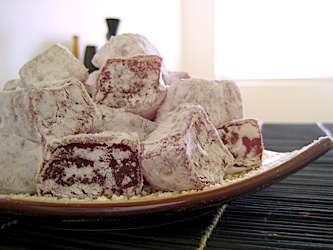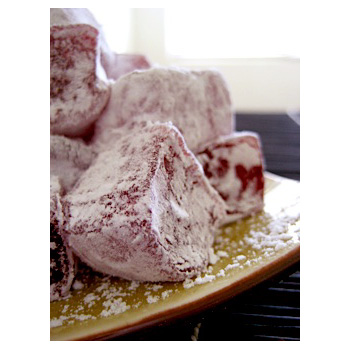
Turkish Delight
Ingredients:
2 cups sugar2 1/4 cups water
Juice of 1/2 lemon or 1/2 Tablespoon of Lemon Juice
1/2 cup cornflour Or Corn Starch
1/2 teaspoon cream of tartar (this stops the mixture from crystalising)
1/2 tbsp essence of rose water
1/2 cup icing sugar Or Powdered Confectioners Sugar
1/8 cup extra cornflour or Cornstarch
Method:
1. Boil the sugar with the lemon juice and 3/4 cups of water. Use a jam thermometer and remove from the heat when the syrup reaches the soft ball stage (115C).
2. While you are boiling the sugar syrup, combine the cream of tartar and a cup of Cornstarch with 1.5 cups of cold water. (Using cold water should prevent lumps.) Mix well and bring up to a simmer, stirring all the time. Continue stirring at a simmer until the mixture has made a thick, gluey paste. Stir the sugar syrup into this paste. (If you end up with lumps at this stage, push everything into a saucepan through a sieve with the back of a ladle.)
3. Simmer the sugar and cornstarch mixture, stirring every few minutes, until it’s a golden-honey colour and about 120C (this is halfway between soft and hard ball on your jam thermometer, and will take about an hour).
4. Divide the mixture into two, and pour it into prepared trays lined with oiled cling film. I used a small tupperware as I wanted turkish delights with a bit of height to them and found that with my trays they were really flat.
5. Add rose water and a few drops of pink food colouring and stir. Cover and chill for a few hours until set. Or over night.
6. Turn it out and slice the set Turkish Delight into cubes, and roll in a mixture of 1/2 cup powdered sugar and 1/8 cup Cornstarch so that they don’t stick together. Store in airtight boxes between layers of greaseproof paper, well-dusted with the powdered sugar/cornstarch mixture.

Rhubarb Turkish Delight
2 cups of rhubarb simple syrup
1 envelope of gelatin powder
2 tablespoons of cornstarch
1/4 + 1/4 cup of water
2 tablespoons of cornstarch and 4 tablespoons of icing sugar
Line the bottom and sides of a standard loaf pan with plastic wrap. Sift the cornstarch with the icing sugar and set aside.
Soften the gelatin powder in 1/4 cup of warm water. Let it bloom until fully hydrated. At the same time, dissolve the cornstarch in 1/4 cup of cold water. Mix to make a slurry.
Put the rhubarb simple syrup in a non-reactive pot. Add the softened gelatin and the cornstarch mixture. Stir to blend completely.
Heat over medium high heat for about 15 - 20 minutes, approximately 112C.
Remove from the heat and cool slightly. Then pour into the prepared pan. Let sit 12 hours at room temperature. Do not refrigerate.
Remove the jellied mixture from the pan and place on a cutting board that has been liberally dusted with the cornstarch and icing sugar mixture. Dust the top of the jellied mixture, as well. With a clean, sharp knife cut into desired shapes and sizes. Carefully toss the jellied candy in the cornstarch and icing sugar mixture. Place on parchment paper to dry.
Do not store in the refrigerator. Store in a tightly closed container in a cold room. This will keep up to 3 months.
Cooks Notes:
Temperature. With a definite concentration and time for setting, solidification occurs only with a definite temperature. For a high solidifying temperature a high concentration of gelatin is required. The slower a gelatin solution is cooled, the higher the temperature at which it solidifies. A gelatin solution may be cooled down, by packing ice around its container, to a temperature below that at which setting would occur if a longer time is allowed. On the other hand, gelatin solutions may be mixed and left standing for 2 or 3 hours at room temperature. If they are then put in ice or the refrigerator they set quite rapidly and as if gel nuclei might have started to form while standing at room temperature. At low temperatures all gelatins become firmer. At high temperatures they are liquid, for no gel occurs at temperatures above 35°C. with any concentration of gelatin. With the same concentration one gel may set at 10°C, another at 12°, still another at 14° to 16°C, and others require lower temperatures for setting. The gelatin's that set at higher temperatures show jellies of greater firmness than those that set at low temperatures. The ones requiring lower temperatures than 10°C. to set do not serve very well, for they also soften at a low temperature.
